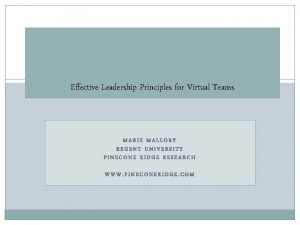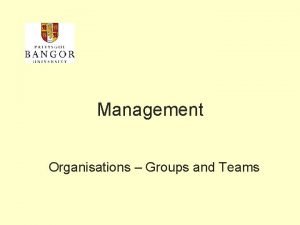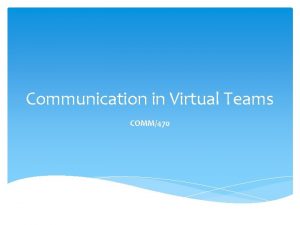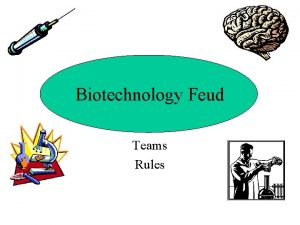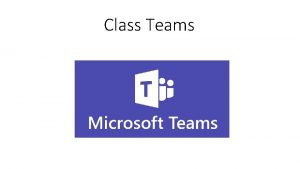Effective Leadership Principles for Virtual Teams MARIE MALLORY

















- Slides: 17

Effective Leadership Principles for Virtual Teams MARIE MALLORY REGENT UNIVERSITY PINECONE RIDGE RESEARCH WWW. PINECONERIDGE. COM

A Virtual Team: �a group of individuals who work across time, space and organizational boundaries with links strengthened by webs of communication technology. � Also known as: � Geographically Dispersed Team � Distributed Team � Remote Team http: //en. wikipedia. org/wiki/Virtual_team

Benefits of the Virtual Team: Flexibility & Availability Comparatively Low Cost Effective Results

Drawbacks of the Virtual Team Funding Challenges Increased Work Time Increased Cognitive Burden (Information Overload) Richardson, La. France & Beck, 2015

Leading a Virtual Team

Leading the Virtual Team: Primary Challenges Relationship Building Effective Communication Managing Conflicts Leadership Maznevski, Davison & Jonsen, 2006


2 Styles of Leadership: Comparison Transactional Transformational �Motivates individual �Motivates followers effort by engaging in exchange with the follower �Behaviors: Clarifies task expectations Provides rewards when expectations are met Reduces cognitive effort intrinsically �Behaviors: Helps followers indentify with the group’s vision and perspectives Serves as a role model Negatively associated with short-term tasks Increases cognitive effort Bass, 1998 / Judge & Piccolo, 2004 / Jung, 2001 / Kahai, Jestire & Huang, 2013

Can You See the Difference? Coach & Mentor Provide Meaning & Interest Transformational Leaders Inspire Lead by Example

Other Virtual Leadership Styles Participative: linked to higher member participation when an appointed leader exists. Directive: higher performance & participation levels than face-to-face teams. Cruz, Henningsen & Smith, 1999 Kahai, Sosik & Avolio, 2004

The Role of the Virtual Team Leader Monitoring team member behavior, performance & progress Devising & implementing effective solutions to issues Direct interaction with team members Bell & Kozlowski, 2002

The Effective Virtual Leader: Communicates Reciprocally Goals Responsibility • Offers feedback • Provides prompt responses • Communicates regularly • Clean • Clear • Precise • Clear directions • Clear division of tasks

Effective Leaders Are: § Cordial, yet assertive § Understanding § Empathetic § Authoritative § Neither arrogant nor timid Kayworth & Leidner, 2002

The Effective Virtual Leader: Mentors & Models

The Effective Virtual Leader: Is a Role Model The most effective leaders exhibit “strong relational skills through their mentoring activities with team members… First and foremost, team members wanted a mentor – someone to guide, to encourage, and to motivate them to excellence. ” Kayworth & Leidner, 2002, p. 27


References Bass, B. M. (1998). Transformational leadership: industrial, military, and educational impact. Mahwah, NJ: Lawrence Erlbaum Associates. Bell, B. S. & Kozlowski, S. W. J. (2002). A typology of virtual teams: Implications for effective leadership. Group and Organizational Management, 27(1), 14 -49. Cruz, M. G. , Henningsen, D. D. & Smith, B. A. (1999). The impact of directive leadership on group information, sampling, decisions, and perceptions of the leader. Communication Research, 26(3), 349 -369. Judge, T. A. & Piccolo, T. F. (2004). Transformational and transactional leadership: a meta-analytic test of their relative validity. Journal of Applied Psychology, 89(5), 755– 768. Jung, D. I. (2001). Transformation and transactional leadership and their effects on creativity in groups. Creativity Research Journal, 13, 185 -195. Kahai, S. S. , Sosik, J. J. & Avolio, B. J. (2004). Effects of participative and directive leadership in electronic groups. Group & Organization Management 29(1), 67– 105. Kahai, S. Jestire, R. & Huang, R. (2013). Effects of transformational and transactional leadership on cognitive effort and outcomes during collaborative learning within a virtual world. British Journal of Educational Technology, 44(6), 969 -985. Kayworth, T. R. & Leidner, D. E. (2002). Leadership effectiveness in global virtual teams. Journal of Management Information Systems, 18(3), 7 -40. Maznevski, M. , Davison, S. C. & Jonsen, K. (2006). Creating Effective Virtual Teams. IMD. Retrieved from http: //www. imd. org/research/challenges/TC 058 -06. cfm Richardson, J. W. , La. France, J. & Beck, D. (2015) Challenges of Virtual School Leadership. American Journal of Distance Education, 29(1), 18 -29, DOI: 10. 1080/08923647. 2015. 992647 Yukl, G. A. (1998). Leadership in Organizations. Prentice Hall, Englewood Cliffs, NJ.
 Principles of effective leadership in virtual teams
Principles of effective leadership in virtual teams Characteristics of effective teams
Characteristics of effective teams Characteristics of effective teams
Characteristics of effective teams Mallory ptah stain
Mallory ptah stain Mallory jeopardy
Mallory jeopardy Tissue processing steps
Tissue processing steps Patologia ficatului
Patologia ficatului Mallory lynch
Mallory lynch Mallory drury
Mallory drury Brockels chocolates
Brockels chocolates Jill mallory
Jill mallory Desplazador de platina del microscopio
Desplazador de platina del microscopio 5fs of abdominal distension
5fs of abdominal distension Mallory martinez
Mallory martinez Esophagus
Esophagus Mallory bales
Mallory bales Virtual teams are often slowed down by difficulty with
Virtual teams are often slowed down by difficulty with Early contingency theories of effective leadership
Early contingency theories of effective leadership
